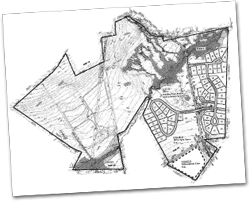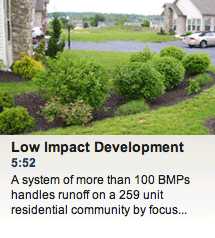
An ounce of prevention truly is worth a pound of cure – and prevention comes from properly planning for stormwater runoff before any construction begins.
- Planning |
- Site Design |
Planning
 Effective stormwater management plays a crucial role in maintaining and maximizing the value of our water resources. There was a time when stormwater management was considered an afterthought; it took place late in the development process, long after building and siting decisions had already been made. Today, we know better.
Effective stormwater management plays a crucial role in maintaining and maximizing the value of our water resources. There was a time when stormwater management was considered an afterthought; it took place late in the development process, long after building and siting decisions had already been made. Today, we know better.
Stormwater management should be taken into account early in the planning process and should play an integral role throughout construction. Low Impact Development; Environmental Site Design; Smart Growth; Growing Greener by Design: all include stormwater management as a key concern.
A dizzying array of factors go into developing stormwater management plans, and each can vary widely depending on location. Soil types, amount and kinds of vegetative cover, landscape gradients, underlying geology, hydrology are but a handful of the many natural features that must be carefully considered before undertaking development of any site.
Planning, meeting permit and ordinance requirements, incorporating BMPs: this may be well and good for undeveloped areas, but what do older, “built out” communities do to deal with runoff problems that are the result of development that occurred in the past?
Incorporating “green” features into infrastructure decisions is an increasingly viable method of improving stormwater management in many situations—and besides the stormwater functions, many such elements bring other benefits to communities.
Related Videos
Check out how two very different developments dealt with stormwater management by planning ahead:
Related News from our Blog
PA Stormwater Standards
In Pennsylvania, the regulatory standards for post construction stormwater discharges state that:
- In Areas Tributary to High Quality and Exceptional Value (Special Protection) Waters—there shall be no degradation of existing or designated stream quality through a change in post construction stormwater runoff volume, rate and quality.
- In Areas Tributary to Waters other than Special Protection—any change in post construction stormwater runoff volume, rate and quality shall not impair existing or designated uses, whichever use is more stringent.
The PA DEP Stormwater Best Management Practices Manual offers guidance for achieving these standards by focusing first on prevention and second on mitigation. Its comprehensive, integrated approach is based on ten basic principles:
- Managing stormwater as a resource;
- Preserving and utilizing existing natural features and systems;
- Managing stormwater as close to the source as possible;
- Sustaining the hydrologic balance of surface and ground water;
- Disconnecting, decentralizing and distributing sources and discharges;
- Slowing runoff down, and not speeding it up;
- Preventing potential water quality and quantity problems;
- Minimizing problems that cannot be avoided;
- Integrating stormwater management into the initial site design process; and
- Inspecting and maintaining all BMPs.
Chapter 3 of the BMP Manual provides an in-depth discussion of these principles and the control guidelines required to meet the standards.



